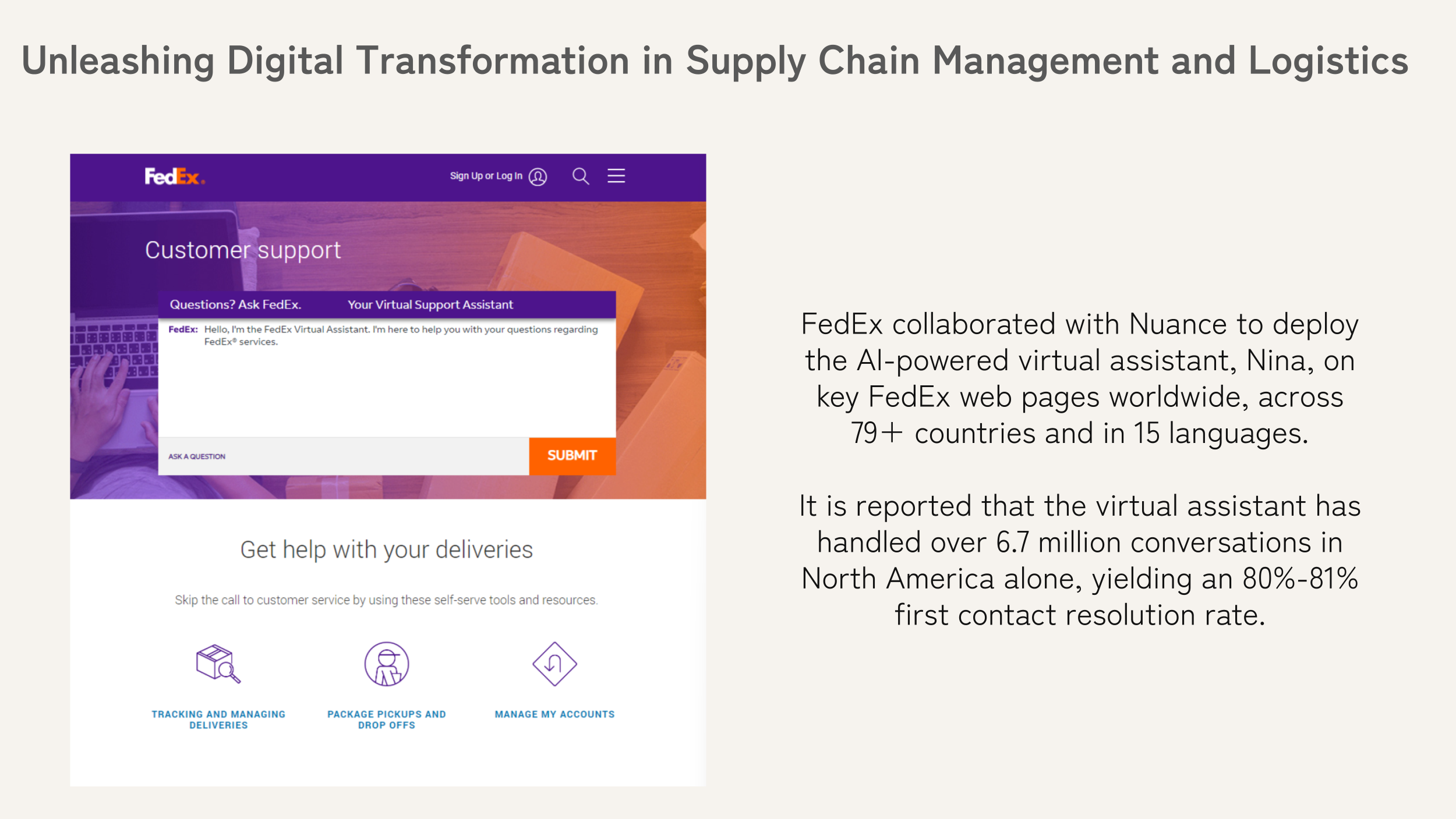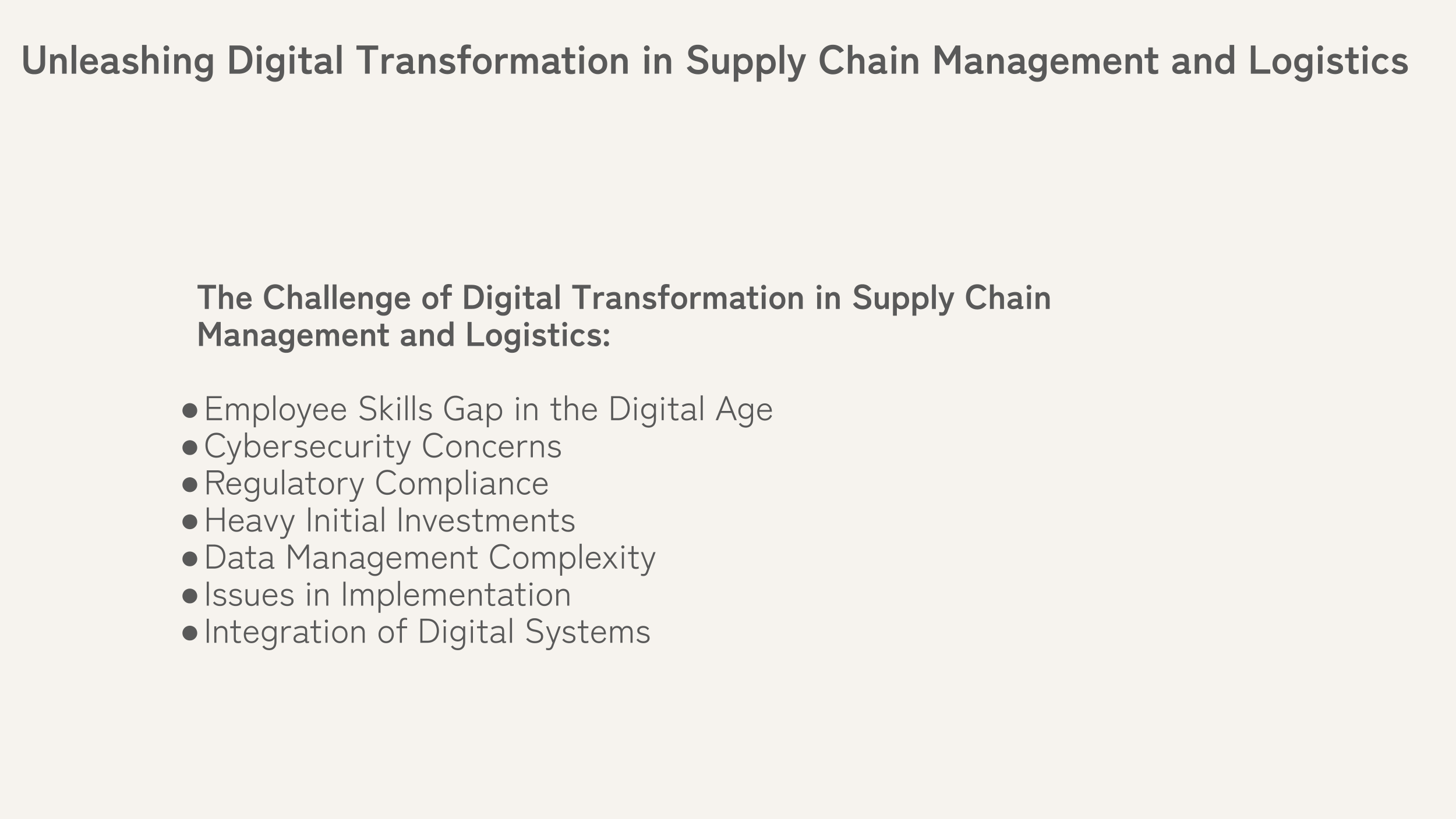
Introduction
In today’s rapidly evolving business landscape, technological innovations have paved the way for a major shift in how organizations approach supply chain management and logistics. Supply Chain Management and Logistics encompass the flow of goods, data, and finances from the point of origin to consumption. With a multitude of components involved - ranging from procurement, production, inventory management, transportation, and customer service - maintaining efficiency at each stage can be a huge task. However, digital transformation, aptly termed as the fourth industrial revolution, is making this colossal feat achievable. Unleashing the potential of digital transformation is crucial to strengthening competitiveness, enhancing efficiency, and providing a more transparent and customer-centric experience. This blog will explore the ins-and-outs of digital transformation, examining its benefits, examples, and challenges of its implementation.Understanding Digital Transformation in SCM and Logistics
Digital transformation in supply chain management (SCM) and logistics involves the integration of digital technologies into all aspects of a business, fundamentally changing how you operate and deliver value to customers. It isn’t merely about digitizing records and automating tasks, but evolving business mindset, culture, and operations to harness the power of technology. In the context of SCM and logistics, this shift affects every step of the process from procurement, inventory management, and warehouse operations to transportation and customer service. This transformation leverages technologies like AI, blockchain, IoT, and robotics to enhance organizational agility, customer service, reduce costs, and mitigate risks. In a nutshell, digital transformation in SCM and Logistics implies using digital technology to improve, innovate, and streamline all processes involved in this sector.The Benefits of Digital Transformation in Supply Chain Management and Logistics
Efficiency and Productivity Gain
Leveraging digital technologies in SCM and logistics can lead to marked gains in efficiency and productivity. Automation and AI, for example, have the potential to significantly cut down on operational costs. McKinsey reports that automation can reduce operational costs by up to 15%.Real-Time Visibility and Traceability
With globalization impacting every industry, real-time tracking and traceability of goods have become more important than ever. IoT and RFID tags, for instance, can provide real-time visibility into product location and quantities.Improved Inventory Management
Digital transformation in SCM allows businesses to manage inventory more accurately and efficiently. The Boston Consulting Group reveals that effective inventory management via digital transformation can help reduce costs from 20% to 50%.Enhanced Forecasting and Demand Planning
AI and machine learning are game-changers for demand forecasting. McKinsey shares that by integrating AI in demand forecasting, companies can improve the forecast accuracy by up to 50%.Customer Service Revamp
Digital transformation does wonders for customer service, with benefits such as real-time tracking, AI-powered chatbots, and personalized recommendations. Gartner predicts that by 2025, up to 80% of customer service interactions will be managed without a human.Cost-Effective Operations
Efficiency gains, error reduction, inventory optimization, and streamlined logistics all contribute to cost savings.Greater Transparency and Compliance
Digital transformation offers enhanced transparency and compliance. Blockchain, for instance, provides a certain level of transactional immutability which aids in product authenticity verification and regulatory compliance.How Digital Transformation Enhances Supply Chain Efficiency
Digital transformation is revolutionizing supply chain management (SCM) and logistics, delivering groundbreaking efficiency, speed, and cost-effectiveness. Here, we provide some transformative examples of digital applications reshaping the industry.Real-time Inventory Management
Before digitalization, inventory management was cumbersome and prone to human errors. Today, with technologies like IoT, GPS, and RFID, companies can now monitor their supply chains in real-time. Real-time visibility into shipments, inventory levels, and the status of goods in transit eliminates guesswork and enables quick decision-making, enhancing efficiency significantly. For example, Amazon uses Kiva robots in its warehouses. These robots move shelves to workers, reducing time and foot traffic, thereby enhancing productivity, efficiency, and safety in warehouses.Efficiency through Automation
Robotics and automation can take over repetitive tasks, drastically reducing human error and maximizing operational efficiency. From automated warehouse systems managing storage and retrieval to AI-enabled customer service, automation can imbibe efficiency at every supply chain level.Predictive Analytics
Predictive analytics is another powerful tool for SCM. It provides valuable insights to predict customer demand, analyze market trends, and customize services. It enables forecasting that can prevent over or under-stocking situations and optimize warehouse space. Predictive analytics goes a long way in achieving lean operations and reducing wastage.Smart Transportation
Digital transformation in transportation is characterized by GPS tracking, AI-based route optimization, and real-time shipment updates. Technology can analyze various parameters like traffic, weather, and fuel cost in real-time and identify the most efficient routes, reducing delivery time and fuel consumption. Uber Freight is a prime example, connecting carriers and shippers on a single platform. It provides real-time tracking, eliminates paper logs, and reduces empty miles, significantly improving shipping efficiency.Blockchain for Traceability
Blockchain, with its unalterable ledger system, has been adopted by many companies for enhanced supply chain transparency and traceability. This tool helps prevent counterfeit operations and ensures product authenticity. Walmart is leveraging blockchain for food safety. In case of a food safety issue, the company can quickly track and recall affected items, preventing potential health hazards.Smart Warehousing
Digital technologies have redefined warehousing operations. IoT enabled technologies and RFID tagging can help manage inventory efficiently, minimizing stock discrepancies. Further, the use of robotics in stock picking, packing, and sorting improves accuracy, and reduces time and operating costs.AI in Customer Service
AI-powered chatbots and automated customer service portals answer queries, track orders, and provide personalized recommendations. This technology reduces pressure on customer service representatives and enhances customer experience. An example is FedEx’s AI-powered chatbot that helps customers track shipments, find drop-off locations, and get price quotes, providing faster and more efficient customer service.
Robust Risk Management
Digital transformation equips businesses with tools to recognize, evaluate, and swiftly respond to risks. AI-based tools can predict disruptions and enable planning for potential hurdles. Swift risk detection and mitigation promise smoother supply chain operations and fulfill customer expectations reliably.Route Optimization
Using AI-powered GPS and tracking systems, logistics operations can determine the most efficient routes, taking into account real-time parameters like traffic, weather conditions, and fuel costs. Route optimization leads to reduced costs, timely deliveries, lower carbon emissions, and improved customer satisfaction.The Challenge of Digital Transformation in Supply Chain Management and Logistics
 As the world increasingly turns digital, the pressure on the supply chain management (SCM) and logistics industry to adapt and evolve heightens.
While the prospect of digital transformation offers promising rewards - improved efficiency, cost savings, and enhanced customer service - the road to digitalization poses its unique challenges.
Let’s delve deeper into these hurdles and explore potential solutions.
As the world increasingly turns digital, the pressure on the supply chain management (SCM) and logistics industry to adapt and evolve heightens.
While the prospect of digital transformation offers promising rewards - improved efficiency, cost savings, and enhanced customer service - the road to digitalization poses its unique challenges.
Let’s delve deeper into these hurdles and explore potential solutions.